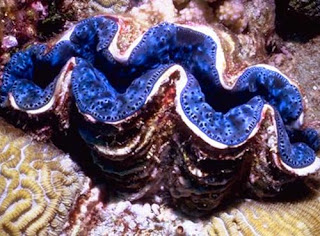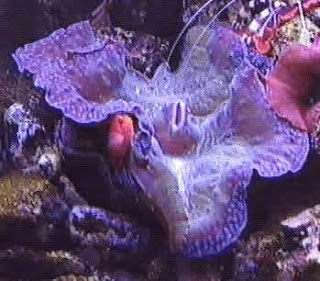Animal Wildlife | Giant Clam | The giant clam is the largest immobile mollusc in the world, with the occasional giant clam individual reaching nearly 6ft in length. Once the giant clam has settled somewhere the giant clam remains there for the rest of its life. Giant clams are founded anchored to the coral reefs in the warm, tropical waters of the Indian and South Pacific oceans, where giant clams spend the majority of their time feeding on the abundant variety of food that a coral reef has to offer.
Due to the large size of the giant clam, there have been reports of giant clams eating human beings. Despite this though, no reports of man-eating giant clams have ever been verified as it is thought that the giant clam would simply hide in its shell rather than attack an approaching human. Giant clams are thought to grow to such enormous sizes due to the fact that giant clams consume a great deal of sugars and proteins that are produced by the algae that live on the giant clams.
Although giant clams are omnivorous animals and therefore eat a mixture of both plant and animal matter, the nutrients produced by the algae provide the main source of food for the giant clam. Giant clams are also known to eat small food particles and animals that are present in the surrounding water. Despite the vast size of the giant clam, giant clams are preyed upon by a number of marine predators, many of which are actually much smaller in size than the giant clam itself. Eels, snails, fish and starfish are all known to snack on small parts of the giant clam.
Giant clams are also preyed upon by humans, who catch the giant clams in order to feed on a particular muscle which is seen as a culinary delicacy in many countries. The excessive harvesting of giant clams by humans has led to rapid declines in the world's giant clam population. Giant clams have both male and female reproductive organs but are not thought to self-fertilise. Giant clams release eggs and sperm into the water, where the eggs will generally be fertilised by the sperm from another giant clam. Giant clams are able to release more than 500 million eggs at a time.
Once fertilised, the eggs of the giant clam float around in the water for around 12 hours when the larvae hatches out. The giant clam larvae than begins to produce a shell and with just a few days, is big enough to find somewhere to settle on the sea floor. Once a giant clam has found somewhere in the reef that it likes, it anchors itself onto the reef where it remains for the rest of its life. Giant clams are so successful within their environment that it is not uncommon for these giant molluscs to live for more than 100 years!
Tags: clam antivirus linux, clam av windows, clam antivirus windows, clam linux, clam av linux, clam windows, clam for windows, clam power, clam packaging, clam stock, cute clam, plastic clam shells, blood clam, define clam, clam boxes, clam bake catering, clam antivirus review, cd clam cases, clam update, clam antivirus download, clam cd cases, clam dredge, cd clam shells







0 Response to "Giant Clam"
Post a Comment